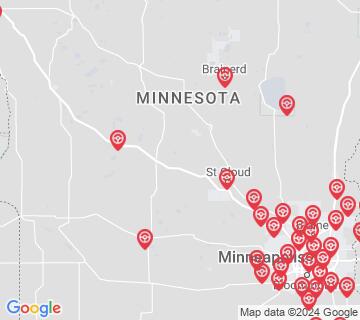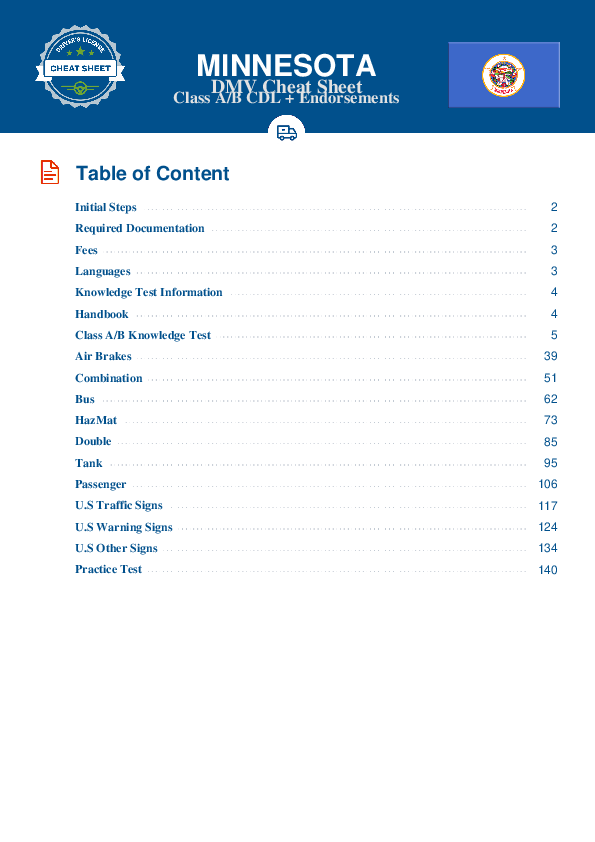Combination #2
Combination Vehicles Practice Test | Minnesota 2025 #2 Page 2 of 3
Train for FREE online with our Minnesota CDL combination vehicle test. The official exam test consists of several obligatory parts, with all of them checking your knowledge of different blocks of road rules. If you need to obtain a MN combination license in 2025, practice as much as possible. Free sample tests published on our website will help you check and improve your knowledge and boost your grades. Please bear in mind that DMV requirements for issuing a combination license may vary from state to state.
20
16
20
8 . When driving with trailers, you should:
To reduce the risk of tipping over when driving with a trailer, you should steer gently and smoothly. Avoid making sudden movements.
9 . Combination vehicles need extra space on the road because they:
Combination vehicles need more space on the road than other commercial vehicles because they are longer and need more space to turn and stop. It is especially important to properly manage space when you are operating a combination vehicle.
10 . To prevent a trailer from rolling over, you should:
Drive slowly around corners.
To reduce the risk of a rollover when driving a combination vehicle, you should keep the weight of the cargo as low to the ground as possible and drive slowly around turns.
11 . The best way to recognize that your trailer has begun to skid is by:
Listening to the radio.
The earliest and best way to recognize the beginnings of a trailer skid is by seeing the trailer veer off-course in your mirrors.
12 . If a parked trailer does not have spring brakes, you should keep the trailer from moving by:
If a parked trailer does not have spring brakes, wheel chocks should be used to prevent it from moving.
13 . What happens when the wheels of a trailer lock up?
The trailer will stop.
A trailer tends to swing around, potentially resulting in a trailer jackknife, if its wheels lock up.
14 . If an air supply control is in its "emergency" position:
Tractor protection controls in older vehicles may be operated by levers instead of knobs. If an air supply control is set in its "emergency" position, the air supply will be stopped and the trailer emergency brakes will be applied.
Search the best driving school in your neighbourhood
2025 Minnesota | Frequently Asked Questions
A CDL Class B license in Minnesota allows the holder to operate single vehicles with a Gross Vehicle Weight Rating (GVWR) of 26,001 pounds or more, or a vehicle towing another not exceeding 10,000 pounds. This includes buses, farm labor vehicles, and any vehicle designed to transport 24 passengers or more, including the driver.
A Class B CDL (Commercial Driver's License) in Minnesota allows the holder to operate single vehicles with a GVWR (Gross Vehicle Weight Rating) of 26,001 or more pounds, or any such vehicle towing another not in excess of 10,000 pounds. This includes straight trucks, large buses, segmented buses, and dump trucks with small trailers.
To acquire a Class B CDL license in Minnesota, you must be at least 18 years old (21 for interstate driving), have a valid Minnesota driver's license, pass a vision test, and successfully complete a knowledge test for the type of vehicle you plan to drive. Additionally, you must pass a skills test, which includes a pre-trip vehicle inspection, basic controls test, and on-road driving examination.
In Minnesota, you must be at least 18 years old to qualify for a Class B CDL license. However, it's important to note that while this age allows you to operate commercial vehicles within the state (intrastate), you must be at least 21 years old to drive commercial vehicles across state lines (interstate).
While not always necessary, specific endorsements may be required for a Class B CDL license in Minnesota depending on the type of vehicle you plan to drive or the cargo you intend to carry. These endorsements could include passenger, school bus, tanker, hazardous materials (HazMat), or combination vehicle endorsements. Each endorsement requires passing additional knowledge and skills tests.
The Class B CDL skills assessment in Minnesota encompasses three areas: pre-trip vehicle inspection, basic vehicle control, and on-road driving. The pre-trip inspection tests your ability to assess the safety of your vehicle. Basic control tests your ability to maneuver and control the vehicle. On-road driving tests your ability to safely operate the vehicle in various traffic situations.
Class B CDL license holders in Minnesota are restricted to operating vehicles under 26,001 lbs. They can't operate Class A vehicles unless they have the appropriate endorsements. Additionally, they may be limited by any restrictions noted on their license, such as "no air brake equipped vehicles", "automatic transmission only", or "no passengers" in commercial buses or vans.
Yes, in Minnesota, the written Class B CDL test is available in several languages other than English. However, federal regulations require that all CDL holders must be able to read and speak English sufficiently to converse with the general public, understand highway traffic signs and signals, respond to official inquiries, and make entries on reports and records.
Yes, you can request accommodations for the Class B CDL written exam if you have a disability. The Minnesota Department of Public Safety is committed to providing equal access to its services. Contact them directly or visit their website for information on how to request accommodations. It's advisable to make your request well in advance of your scheduled test date.
Yes, if you don't pass the Class B CDL written test in Minnesota, you can retake it. However, you must wait until the next day to retake the test. There is no limit to the number of times you can retake the test, but a retesting fee will be charged each time after the first two attempts.




